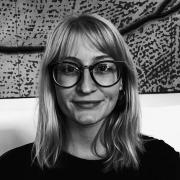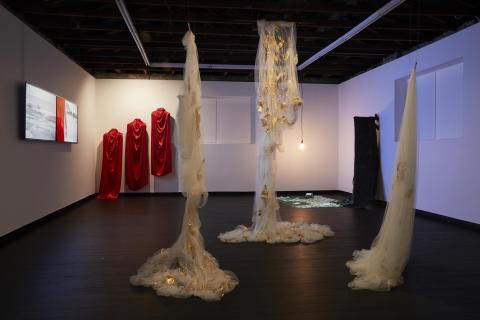Warm Bodies, Curated by Megan Monte and Josephine Skinner
The glitch narrative frames the exhibition, as I walk up the stairs into Cement Fondu. Previously, an old tyre factory, the urban environment remains, and on a grey rainy day in Sydney it’s easy to feel as though you have walked into a dystopian, abandoned art gallery. The glitchy TV screens sit perched on top of the hefty concrete stairs as I pull my body up, I turn the corner and face the horror show within. It’s hot in the gallery, but I’m not sure whether this is because of my temperature rising as the anxiety of the room thickens. I can see more of the flickering TVs, old analogue bricks, collected in groups, as though the artist, Daniel Connell, has abandoned them. Lightless (2012), a multi-CRT TV installation is dispersed throughout the gallery. Individually, they are subtle, but as you walk around the former industrial factory, the images on the screens play with your perception. The light reflects in my glasses, distorting the space around me, adding to the fictional narrative of a horror show. Warm Bodies brings together artists who work with the themes related to their body, the environment, and social issues to explore dystopian futures, as though they are part of a Halloween-esqe nightmare. The curators, Megan Monte and Josephine Skinner, have set the stage, inviting you to consider these narratives that hover on the disturbed line between fact and fiction.
Projected on a large screen in the centre of the room, a movie plays out, the sound booming through the echo-amplifying space. A sense of anxiety is a critical factor to the works in the exhibition, as the artists play on your sensitivity. The sound comes from the dystopian world within the copious screen playing Ditch Plains (2013) from the German artist Loretta Fahrenholz. The characters are dancing and shaping their bodies through an abandoned city, responding to lights, with zombies coming out of the dark to feed on the unsuspecting lurkers in the night. In this work, set in New York during Hurricane Sandy, Fahrenholz explores identity, and also the brutal effects of climate change. The movie may be fictional, yet serves as a reminder that Hurricane Sandy was a reality for many people. The public of New York were divided, depended on their social status, meaning many low-income workers were left without electricity, food, or contact for days. The fictional nightmare in the movie contrasts the real nightmare for many. The central placement of Ditch Plains emboldens the film to set the tone of the exhibition. But while I agree that the Sci-fi dance film lends itself to the horror theme, it’s the more restrained works surrounding this piece that intensify the creeping feeling of Warm Bodies.
For example, Justine Varga’s series: Memoire (2016), a collection of six photographs, are shown across the gallery along with Connell’s old TVs, continuing the themes of loss and memory. Visually the works are like abstracted elements or Petri dishes of bacteria. While Connell’s Lightless shows flickering illuminations—failing artificial lights found around Sydney—Varga’s Memoire series are the results of her mistreatment of the film negatives, exposed to spider nests or the harsh New Zealand weather. Peaks of colour emerge out of the negative space within the frames. Phillip Stearns’ dominating tapestries hang nearby, Memory Fragment—XGQ 222RGB 36px and Memory Fragment—XAA 222RGB 366px from the Fragmented Memory (2013) series sway in the air, suspended from the ceiling. The rich texture and vibrant colours, extracted from Stearns’ computer memory are mechanically turned into larger-than-life tapestries, featuring buzzing lines across the surface, like a computer glitching in yellows, pinks, black, white. The works embrace ideas similar to those behind Varga’s photo series, documentation of physical remains leaving a ghostly emptiness.
Warm Bodies continues the horror story with its performances, traces of which are left in the gallery for the viewer to consider. Safdar Ahmed’s hand-drawn animation work is presented on the wall in the space, while he also performed at the Halloween Party held at the gallery with his Muslim Black Death Metal band Hazeen. The video work, The Subjective Xenophobe (2018) features a dystopian vision of zombies, navigating their way through a fictional reality created by Ahmed and serves as a music video for Hazeen. Zombies traverse Australian landscape, filled with skulls and other creepy objects, while worlds are collapsing on themselves. The difference between more traditional Black Death Metal bands and Hazeen is the union between music and their self-identification with Islamic religion. Hazeen’s performances aim to create a space within the gallery for a deeper understanding of xenophobia and, and to reclaim Islamophobia. The band opens its own discourse, highlighting the absurdity of targeting a religion. Ahmed seems to poke fun at us: why can most of the population handle zombies in popular media but not people of Muslim heritage?
Laetitia Olivier-Gargano occupies the Project Space, situated in the back room of Cement Fondu, with her installation. Here, the peachy pink walls make me feel as though I have entered the human body. The colour, I imagine, is similar to what we would find after our skin has been peeled off. Body parts, hair, mould, and slime, mixed with everyday objects, continue my uneasy feelings of anxiety and self-consciousness permeating through my thoughts. Amplified by the sounds from Fahrenholz’s dystopian nightmare from the main gallery, the sculptures all demand a closer look, as everyday objects are not what they seem. This is still the horror show, but Laetitia Olivier-Gargano’s takeover of the Project Space rejects the dark, moody story played out in the main space, instead highlighting the pure revulsion of the human body. It’s been an uncomfortable year… (2017/18) and The mushrooms between my toes (2015) appear as a table centred in the room, and the latter, a shelf on the wall. A twisted wunderkammer across both surfaces features a fingertip at the end of a sausage in a hot dog roll; teeth in a handful of popcorn, or maggot blending in with the popcorn; a fuzzy testicle sea urchin; pubic-style hairy maggots and apples; teeth perched on the edge of a mug; a tongue protruding out of a peach crack. Two video works—Seed (2018) and Toes (2016)—have creatures and mushrooms poking out of body parts and everyday objects, continuing to build up a feeling of anxiety within my own body.
Meanwhile Adham Faramawy, an Egyptian London-based queer artist has taken over the gallery’s Art Store, joining a collection of takeaways from the exhibition for sale. Faramawy has created an installation, which aims to turn our attention onto the filming lens, and thus, ways of viewing. Here, screens sit upon piles of sand stuffed with plastic water bottles; old makeup containers; and various hair product bottles. The walls are covered with scrunched up posters that seem like they’ve been burned in places; they feature pin-up men, posing with a coquettish stare. Only wearing helmets and tape, they demand our attention. The cisnormative gaze isn’t the presumed norm here. On screens, Make Up Tutorial (2018), features a beauty routine unlike the common ones seen on YouTube, with their white-girl aesthetic. Instead, the stage is set for a Halloween routine: how to turn yourself into a horror creature. Faramawy’s face gets more and more distorted and disturbing, as he layers on the makeup, inserts white contact lenses. Perhaps, the real horror at play here is culture’s tolerance towards some bodies, but not the others.
In Warm Bodies, a social experiment is at play in the body horror and post-apocalypse genre. We can see through the artists’ and curators’ work that everyday phenomena like make-up application, glitching TVs, computer databases, popular heavy music, even a simple teacup are used to explore issues relating to social injustices, environmental catastrophes and the radical redefinitions of identity. The artists included in the exhibition have not only Australian and New Zealand backgrounds, but also American and European. It appears as though a horror concept unites us—through our fear of the unknown and unfamiliar, but also the bizarre nature of humanity to reject what we don’t recognise. The narratives at play in the exhibition work in conjunction with each other, but also create a resistance to challenge pre-conceived ideas in a social utopia.

%20and%20Make%20Up%20Tutorial,%202018.%20Video%20installation%20with%20mixed%20media.%20Photo%20by%20Anna%20Kucera.%20Courtesy%20of%20Cement%20Fondu-itok=6z5MkTDV.jpg)
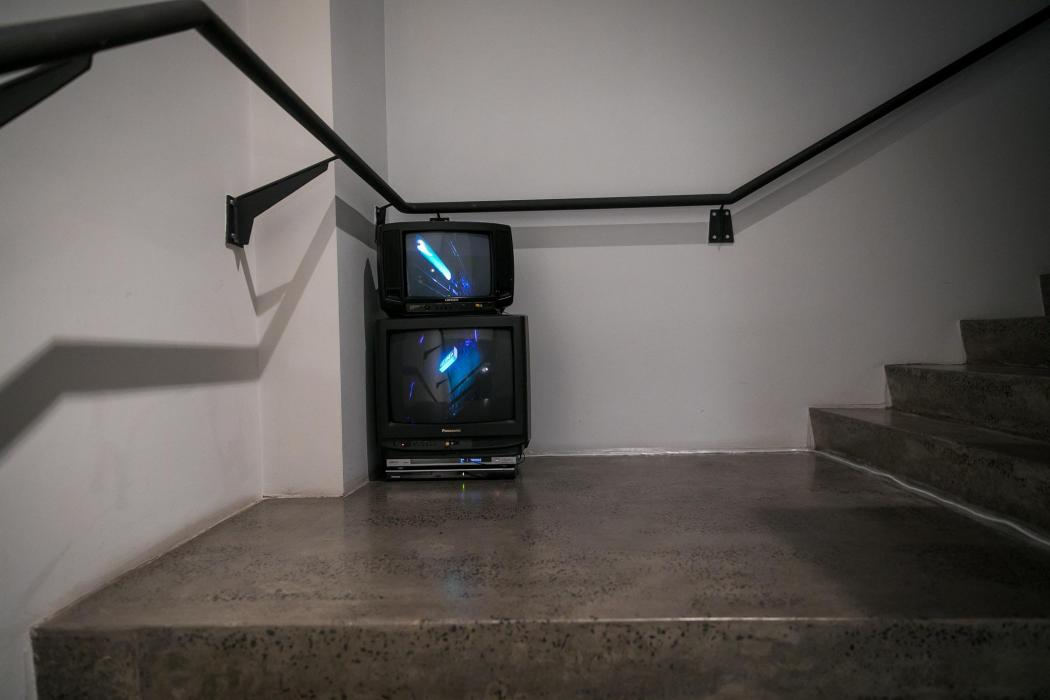
,%202018.%20Photo%20by%20Anna%20Kucera.%20Courtesy%20of%20Cement%20Fondu-itok=dUSqnNX6.jpg)
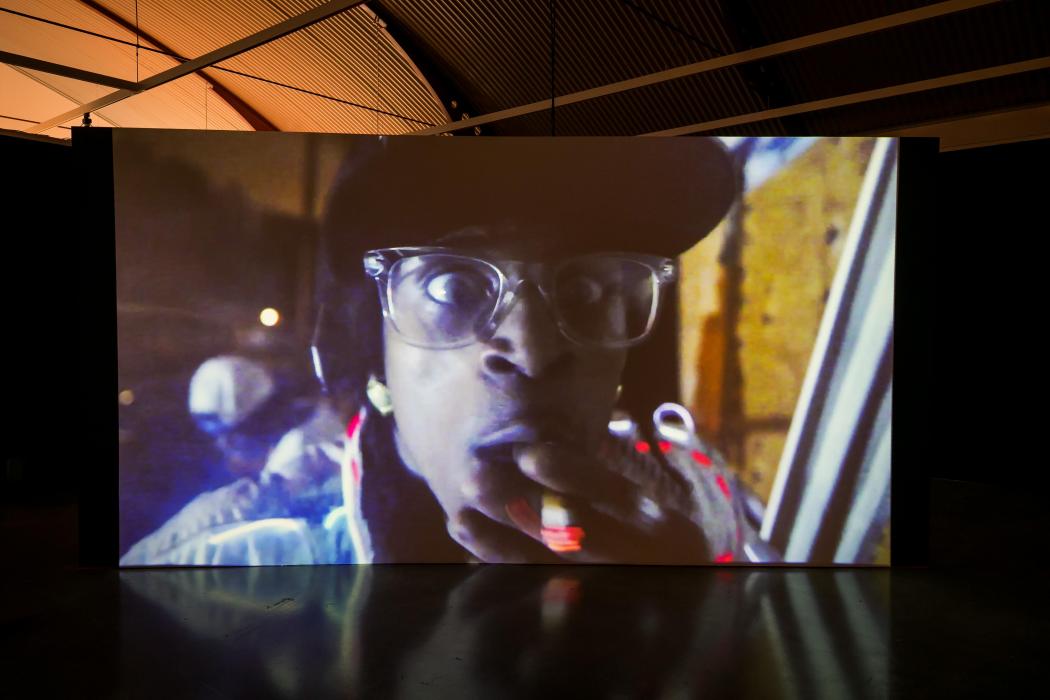
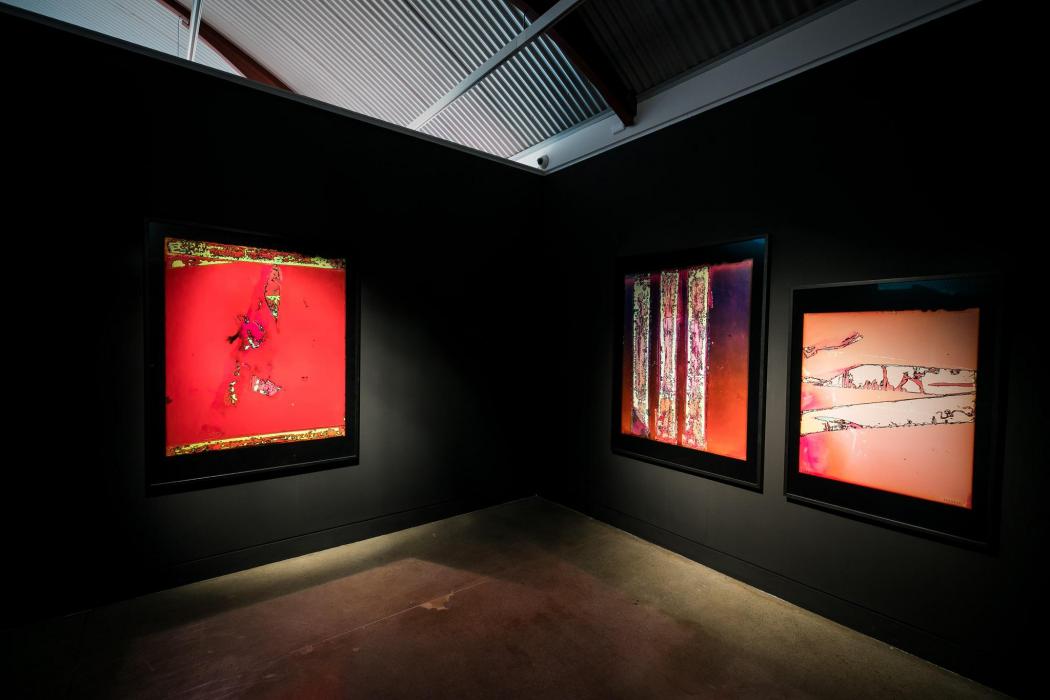
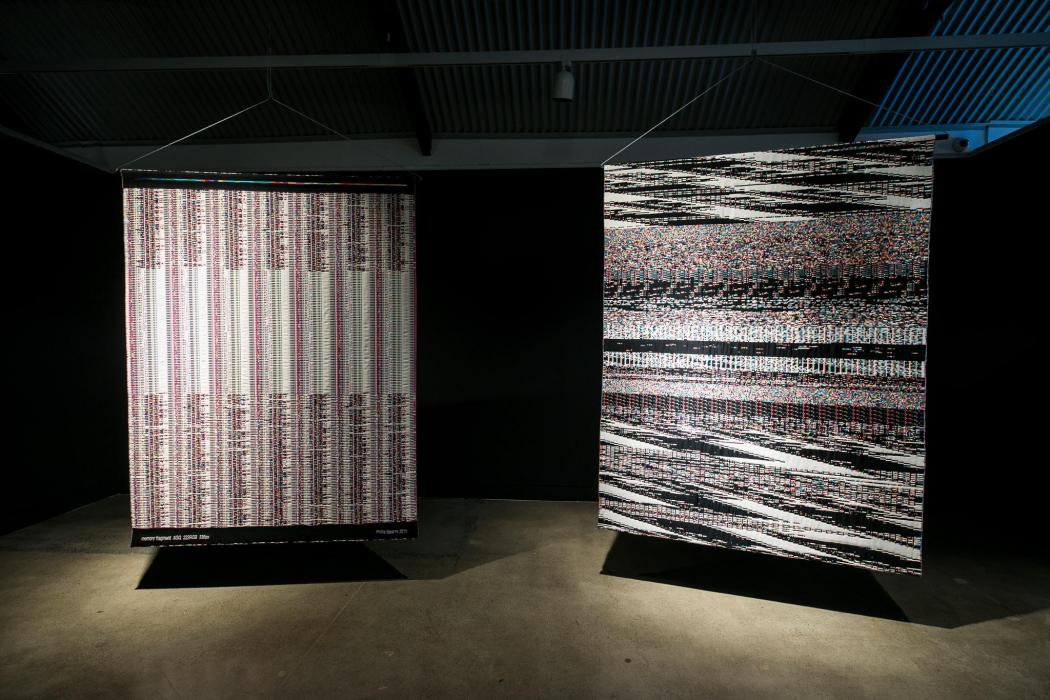
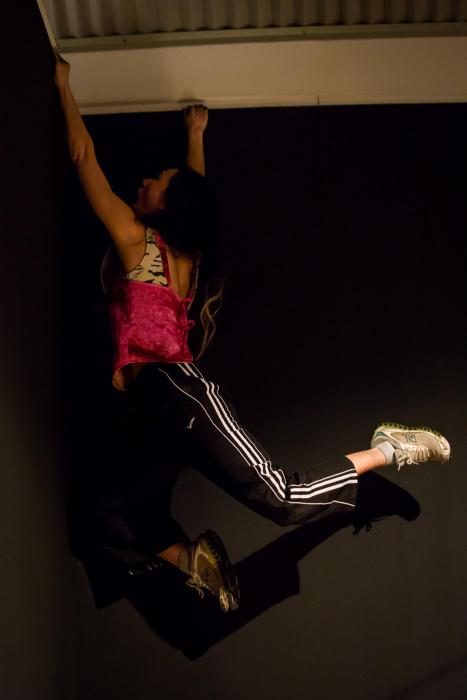
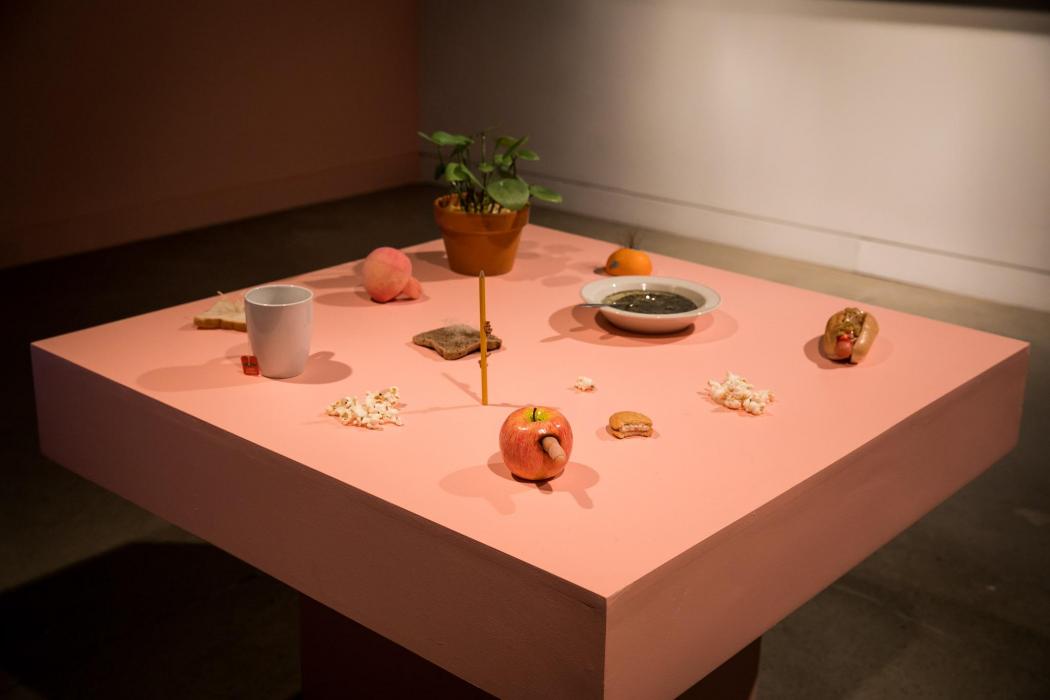
,%202017-18.%20Table,%20collection%20of%20sculptures,%20mixed%20media.%20Photo%20by%20Anna%20Kucera.%20Courtesy%20of%20Cement%20Fondu-itok=ntALom49.jpg)
%20and%20Make%20Up%20Tutorial,%202018.%20Video%20installation%20with%20mixed%20media.%20Photo%20by%20Anna%20Kucera.%20Courtesy%20of%20Cement%20Fondu-itok=QFADigR_.jpg)
